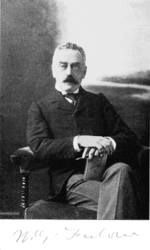William Gilson Farlow
This article includes a list of general references, but it lacks sufficient corresponding inline citations. (March 2013) |
William Gilson Farlow | |
|---|---|
 | |
| Born | December 17, 1844 |
| Died | June 3, 1919 (aged 74) |
| Nationality | American |
| Alma mater | Harvard |
| Scientific career | |
| Fields | Botany |
William Gilson Farlow (December 17, 1844 – June 3, 1919) was an American botanist, born in Boston, Massachusetts, and educated at Harvard (A.B., 1866; M.D., 1870), where, after several years of European study, he became adjunct professor of botany in 1874 and professor of cryptogamic botany in 1879.[1]
Farlow corresponded with Caroline Bingham and Jacob Georg Agardh collaborating in the identification and classification of species of algae previously unknown to science.[2]
Farlow was elected to the American Academy of Arts and Sciences in 1874.[3] In 1899 he was president of the American Society of Naturalists; in 1904 president of the National Academy of Sciences; in 1905 president of the American Association for the Advancement of Science and a member of the American Philosophical Society; and in 1911 president of the Botanical Society of America.[4]
He received honorary degrees from Harvard University, the University of Glasgow (LL.D in 1901),[5] and the University of Wisconsin–Madison.
He was known as the "father" of cryptogamic botany in the United States.[6] Among his students was the phytologist William Albert Setchell.[7]
Among his publications are:
- The Gymnosporangia or Cedar-Apples of the United States (1880)
- Marine Algœ of New England (1881)
- A Provisional Host-Index of the Fungi of the United States (1888)
- Biographical Index of North American Fungi (1905)
With Charles Lewis Anderson and Daniel Cady Eaton he issued the exsiccata series Algae exsiccatae Americae Borealis (1877-1889).[8]
- This article incorporates text from a publication now in the public domain: Gilman, D. C.; Peck, H. T.; Colby, F. M., eds. (1905). New International Encyclopedia (1st ed.). New York: Dodd, Mead.
{{cite encyclopedia}}: Missing or empty|title=(help)
References
[edit]- ^ Dupree, A. Hunter (1988). Asa Gray, American Botanist, Friend of Darwin. Baltimore, MD: Johns Hopkins University Press. p. 351. ISBN 978-0-801-83741-8.
- ^ Setchell, W. A.; Dawson, E. Y. (1941). "Binghamia, the Alga, versus Bighamia, the Cactus". Proceedings of the National Academy of Sciences of the United States of America. 27 (8): 376–381. Bibcode:1941PNAS...27..376S. doi:10.1073/pnas.27.8.376. PMC 1078343. PMID 16588473.
- ^ "William Gilson Farlow". American Academy of Arts & Sciences. February 9, 2023. Retrieved January 25, 2024.
- ^ "APS Member History". search.amphilsoc.org. Retrieved January 25, 2024.
- ^ "Glasgow University Jubilee". The Times. No. 36481. London. June 14, 1901. p. 10. Retrieved January 5, 2024 – via Newspapers.com.
- ^ Goodwin, Richard H. (2002). A Botanist's Window on the Twentieth Century. Harvard Forest, Petersham, Massachusetts, Harvard University. p. 9.
- ^ Campbell, D.H. (1945). "Biographical Memoir of William Albert Setchell 1864–1943" (PDF). Biographical Memoirs of the National Academy of Sciences. 23: 127–147.
- ^ "Algae exsiccatae Americae Borealis, curantibus W. G. Farlow, C. L. Anderson, D. C. Eaton: IndExs ExsiccataID=1875584127". IndExs – Index of Exsiccatae. Botanische Staatssammlung München. Retrieved June 16, 2024.
- ^ International Plant Names Index. Farl.
